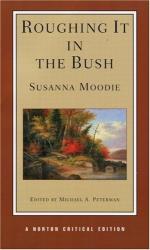The old dragoon had fixed his abode on the verge of an extensive beaver-meadow, which was considered a sort of natural curiosity in the neighbourhood; and where he managed, by cutting the rank grass in the summer time, to support several cows, which afforded the chief subsistence of his family. He had also managed, with the assistance of his devoted partner, Judy, to clear a few acres of poor rocky land on the sloping margin of the level meadow, which he planted year after year with potatoes. Scattered over this small clearing, here and there might be seen the but-end of some half-burnt hemlock tree, which had escaped the general combustion of the log heaps, and now formed a striking contrast to the white limestone rocks which showed their rounded surfaces above the meagre soil.
The “ould dhragoon” seemed, moreover, to have some taste for the picturesque, and by way of ornament, had left standing sundry tall pines and hemlocks neatly girdled to destroy their foliage, the shade of which would have been detrimental to the “blessed praties” which he designed to grow in his clearing, but which, in the meantime, like martyrs at the stake, stretched their naked branches imploringly towards the smiling heavens. As he was a kind of hermit, from choice, and far removed from other settlers, whose assistance is so necessary in new settlements, old Simpson was compelled to resort to the most extraordinary contrivances while clearing his land. Thus, after felling the trees, instead of chopping them into lengths, for the purpose of facilitating the operation of piling them preparatory to burning, which would have cost him too much labour, he resorted to the practice of “niggering,” as it is called; which is simply laying light pieces of round timber across the trunks of the trees, and setting fire to them at the point of contact, by which means the trees are slowly burned through.
It was while busily engaged in this interesting operation that I first became acquainted with the subject of this sketch.
Some twenty or thirty little fires were burning briskly in different parts of the blackened field, and the old fellow was watching the slow progress of his silent “niggers,” and replacing them from time to time as they smouldered away. After threading my way among the uncouth logs, blazing and smoking in all directions, I encountered the old man, attired in an old hood, or bonnet, of his wife Judy, with his patched canvas trousers rolled up to his knees; one foot bare, and the other furnished with an old boot, which from its appearance had once belonged to some more aristocratic foot. His person was long, straight, and sinewy, and there was a light springiness and elasticity in his step which would have suited a younger man, as he skipped along with a long handspike over his shoulder. He was singing a stave from the “Enniskillen Dragoon” when I came up with him.
“With his silver-mounted pistols,
and his long carbine,
Long life to the brave Inniskillen dragoon.”




